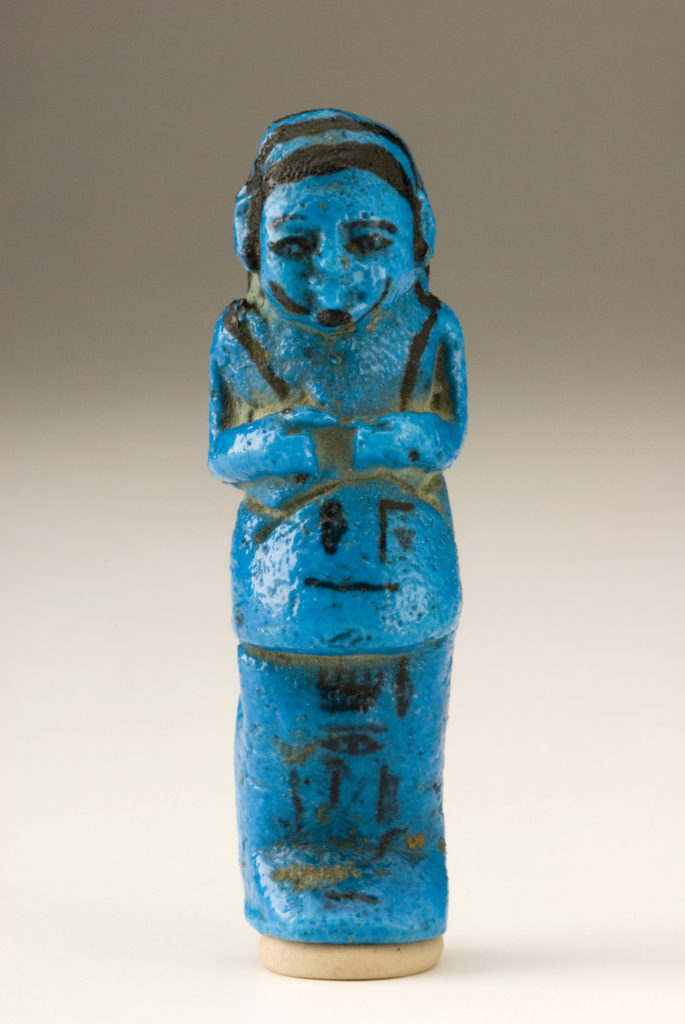Overseer Ushabti (work of art)
Artwork Info
About
Key Ideas
- Ushabtis (oo-shab-tees) are funerary, or burial-related, figurines that were buried in ancient Egyptian tombs. Their purpose was to serve the deceased person in the afterlife.
- A magical spell is written in hieroglyphs on the front of the figure’s body. The spell was a blessing to help the deceased person pass a test in the underworld that would allow them to have a peaceful afterlife.
- The Overseer Ushabti is made from faience (fay-yahns). Faience is a human-made material that was often used in ancient Egypt to create figurines, vessels, jewelry, ritual objects, and architectural ornaments.
Learn More
Ancient Egyptians believed that life went on even after one’s death. This means that even though the deceased could enjoy peaceful rest, they would still have to farm the fields and provide nourishment to themselves. To avoid doing any hard work in the afterlife, wealthy elites and royalty originally buried human servants in graves with them. They wanted to bring their servants with them to the afterlife to do the work for them. This was practiced in the Predynastic (5500 to 3100 BCE) and Early Dynastic Period (3100 to 2686 BCE). In the First Intermediate Period (2181 to 2040 BCE), wealthy individuals began using funerary figurines, or miniature statues, in their burials. The figurines were called shabtis, shawbtis, or ushabtis, depending on the time period and where they were found. Beginning in the New Kingdom Period (1750 to 1550 BCE), the figurines were seen as magic servants that worked on behalf of their owners in the afterlife.
These figurines were stored in ceramic jars or wooden boxes. A full set included 365 servant figurines and 36 overseers, totaling 401. For every 10 servants, there was an overseer to supervise the laborers. The Overseer Ushabti is one of the figurines that acted as an overseer. It is depicted wearing a wig and a beard. Its occupation as an overseer is indicated by the long garment it wears at the waist (suggested by the protruding bump on the lower body). The figure’s arms are folded in front of the chest, with each hand holding a hoe.
A magical spell is written in hieroglyphs on the front of the figure’s body. It translates to “the ‘God’s Father, Beloved of Amen,’ the Osiris, Pinudjem, justified.” Pinudjem (pee-noo-jem) is the name of the deceased person that the overseer worked for in the afterlife. Osiris is the name of the Egyptian god of the dead. Ancient Egyptians believed that after one’s death, their heart would be weighed to see if the person was “morally righteous” during their lifetime. When a dead person passed the test, they were “justified.” The spell written on this figurine was intended to bless Pinudjem and help him pass the test to achieve an eternal afterlife.
Shabtis (or ushabtis) were made from a variety of materials. Overseer Ushabti is made with faience, a glazed ceramic material. Faience was created using a technique called self-glazing. This technique involved using salts (in a wet paste of ground quartz and sand) that rose to the surface when the paste was fired in a kiln. The result was a shiny finish of bright turquoise, blue, and green. Ancient Egyptians often used faience for ritual objects (objects used for religious and ceremonial purposes). The glossy surface of faience was believed to be infused with the power of the sun, representing rebirth.
Additional Resources
Resources for Teachers:
- Read an article about the shabtis (or ushabtis) of ancient Egypt.
- Read an article about occupations and social structures in ancient Egypt.
- Read an article about Egyptian faience.
Resources for Students:
- Watch a video about shabtis.
- View some shabtis (and ushabtis) from different time periods.
- Watch a video about Egyptian faience and learn how it is made.




